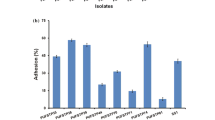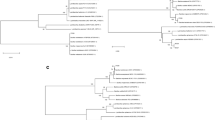Abstract
This study is aimed to isolate some novel probiotics from the soils of North East Himalayas. Eleven Gram positive isolates were obtained in MRS with Oxgall media from soil samples. Four of the isolates withstood the in vitro gastric juice pH 3.0 and 0.45% bile salt tolerance screening. Among these, PBT 3 showed high cell surface hydrophobicity and adhered to the Caco-2 cells. 16s rDNA gene sequences of this probiotic strains were identified as Bacillus amyloliquefaciens (accession no: JF836079). In in vivo bioefficacy evaluation by DSS-induced colitis animals, B. amyloliquefaciens significantly ameliorated the loss in body weight. Further, the treatment altered the levels of myeloperoxidase, lipoperoxides, and mucous content in the colon tissues compared with normal colon. It reduced the protein and mRNA levels of pro-inflammatory cytokines such as TNF-α and IL-1β. These biochemical findings were supported by histopathological evidences. Our study reports the use of B. amyloliquefaciens isolated from Himalayan soil as probiotic and its beneficial effect on IBD for the first time and suggests that this could be used as potential probiotics in functional foods or as a curative agent.






Similar content being viewed by others

References
Bhakta JN, Ohnishi K, Munekage Y, Iwasaki K (2010) Isolation and probiotic characterization of arsenic-resistant lactic acid bacteria for uptaking arsenic. World Academy of Science. Eng Technol 71:470–471
Blandizzi C, Natale G, Gherardi G, Lazzeri G, Marveggio C, Colucci R, Carignani D, Del Tacca M (1999) Acid-independent gastroprotective effects of lansoprazole in experimental mucosal injury. Dig Dis Sci 44:2039–2050
Bobin-Dubigeon C, Collin X, Grimaud N, Robert JM, Le Baut G, Petit JY (2001) Effects of tumor necrosis factor-synthesis inhibitors on rat trinitrobenzene sulphonic acid-induced chronic colitis. Eur J Pharmacol 421:103–110
Cetinkaya A, Bulbuloglu E, Kantarceken B, Ciralik H, Kurutas EB, Buyukbese MA, Gumusalan Y (2006) Effects of L-carnitine on oxidant/antioxidant status in acetic acid-induced colitis. Dig Dis Sci 51:488–494
Chen CC, Walker WA (2005) Probiotics and prebiotics: role in clinical disease states. Adv Pediatr 52:77–113
Deniz M, Cetinel S, Kurtel H (2004) Blood flow alterations in tnbs-induced colitis: role of endothelin receptors. Inflamm Res 53:329–336
EFSA (2004) Opinion of the scientific panel on additives and products or substances used in animal feed on a request from the Commission on the safety of the product “Kemzyme W Dry” regarding the ability of Bacillus strains involved in the manufacture to produce toxins. EFSA J 118:1–4
EFSA (2007) European food safety authority. Introduction of a qualified presumption of safety (QPS) approach for assessment of selected microorganisms referred to EFSA opinion of the scientific committee (Question No EFSA-Q-2005–293). Adopted on 19 November 2007. EFSA J 587:1–16
EFSA (2008) Scientific opinion of the panel on additives and products or substances used in animal feed (FEEDAP) on a request from the European Commission on the safety and efficacy of Ecobiol® (Bacillus amyloliquefaciens) as feed additive for chickens for fattening. EFSA J 773:1–13
Einerhand AW, Renes IB, Makkink MK, Vander Sluis M, Buller HA, Dekker J (2002) Role of mucins in inflammatory bowel disease: important lessons from experimental models. Eur J Gastroenterol Hepatol 14:757–765
Gaggia F, Mattarelli P, Biavati B (2010) Probiotics and prebiotics in animal feeding for safe food production. Int J Food Microbiol 141:S15–S28
Gionchetti P, Rizzello F, Helwig U, Venturi A, Lammers KM, Brigidi P, Vitali B, Poggioli G, Miglioli M, Campieri M (2003) Prophylaxis of pouchitis onset with probiotic therapy: a double-blind, placebo-controlled trial. Gastroenterology 124:1202–1209
Goldin BR, Gorbach SL, Saxelin M, Barakat S, Gualtieri L, Salminen S (1992) Survival of Lactobacillus species (strain GG) in the human gastrointestinal tract. Dig Dis Sci 37:121
Grisham MB, Beniot JN, Granger DN (1990) Assessment of leukocyte involvement during ischemia and reperfusion of intestine. Methods Enzymol 186:729–742
Guarnera F, Schaafsmab GJ (1998) Probiotics. Int J Food Microbiol 39:237–238
Havenaar R, Brink NG, Huis In’t Ved JHJ (1992) Selection of strains for probiotics use. In: Fuller R (ed) Probiotics, the scientific basis. Chapman & Hall, London, pp 210–224
Immerseel FV, Ducatelle R, De Vos M, Boon N, Wiele TVD, Verbeke K, Rutgeerts P, Sas B, Louis P, Flint HJ (2010) Butyric acid-producing anaerobic bacteria as a novel probiotic treatment approach for inflammatory bowel disease. J Med Microbiol 59:141–143
Ishikawa H, Akedo I, Umesaki Y et al (2003) Randomized controlled trial of the effect of Bifidobacteria-fermented milk on ulcerative colitis. J Am Coll Nutr 22:56–63
Kim YG, Moon JT, Lee KM et al (2006) The effects of probiotics on symptoms of irritable bowel syndrome. Korean J Gastroenterol 47:413–419
Kos B, Suskovic J, Vukovic S, Simpraga M, Frece J, Matosic S (2003) Adhesion and aggregation ability of probiotic strain Lactobacillus acidophilus M92. J Appl Microbiol 94:981–987
Kravtsov EG, Yermolayev AV, Anokhina IV, Yashina NV, Chesnokova VL, Dalin MV (2008) Adhesion characteristics of Lactobacillus is a criterion of the probiotic choice. Bull Exp Biol Med 145:232–234
Kruis W, Schutz E, Fric P et al (1997) Double-blind comparison of an oral Escherichia coli preparation and mesalazine in maintaining remission of ulcerative colitis. Aliment Pharmacol Ther 11:853–858
Madsen KL, Doyle JS, Jewell LD, Tavernini MM, Fedorak RN (1999) Lactobacillus species prevents colitis in interleukin 10 gene-deficient mice. Gastroenterology 116:1107–1114
Makharia GK, Sood A, Midha V (2008) 701 A randomised, double blind, placebo controlled trial of a probiotic preparation, VSL#3, for the treatment of mild to moderate active ulcerative colitis. Gastroenterology 134:A-99
Markert M, Andrews PC, Babior BM (1984) Measurement of O2 production by human neutrophils. The preparation and assay of NADPH oxidase-containing particles from human neutrophils. Methods Enzymol 105:358–365
Mayra-Makinen A, Manninen M, Gyllenberg H (1983) The adherence of lactic acid bacteria to the columnar epithelial cells of pigs and calves. J Appl Bacteriol 55:241–245
Mileti E, Matteoli G, Iliev ID, Rescigno M (2009) Comparison of the immunomodulatory properties of three probiotic strains of Lactobacilli using complex culture systems: prediction for in vivo efficacy. PLoS One 4:7056
Ng SC, Plamondon S, Al-Hassi HO et al (2008) Effective probiotic treatment (VSL#3), but not placebo, in acute ulcerative colitis is associated with downregulation of inflammatory intestinal dendritic cells. Gut 57:96
Pelletier C, Bouley C, Cayuela C, Bouttier S, Bourlioux P, Bellon-Fontaine MN (1997) Cell surface characteristics of Lactobacillus casei subsp. casei, Lactobacillus paracasei subsp. paracasei, and Lactobacillus rhamnosus strains. Appl Environ Microbiol 63:1725–1731
Phelps RJ, McKillip JL (2002) Enterotoxin production in natural isolates of Bacillaceae outside the Bacillus cereus group. Appl Environ Microbiol 68:3147–3151
Prakash S, Urbanska AM (2008) Colon-targeted delivery of live bacterial cell biotherapeutics including microencapsulated live bacterial cells. Biologics 2:355–378
Prasad J, Gill H, Smart J, Gopal PK (1998) Selection and characterization of Lactobacillus and Bifidobacterium strains for use as probiotics. Int Dairy J 8:993–1002
Prisciandaro LMG, Butler R, Cummins A, Howarth G (2009) Probiotics and their derivatives as treatments for inflammatory bowel disease. Inflamm Bowel Dis 15:1906–1914
Ramon MA, Villegas I, Sanchez-Hidalgo M, Catalina AL (2006) The effects of resveratrol, a phytoalexin derived from red wines, on chronic inflammation induced in an experimentally induced colitis model. Br J Pharmacol 147:873–885
Rochat T, Bermudez-Humaran L, Gratadoux J, Fourage C, Hoebler C, Corthier G, Langella P (2007) Anti-inflammatory effects of Lactobacillus casei BL23 producing or not a manganese-dependant catalase on DSS-induced colitis in mice. Microb Cell Fact 6:22
Saavedra JM, Bauman NA, oung L, Perman JA, Yolken RH (1994) Feeding of Bifidobacterium and Streptococcus thermophilus to infants in hospital to prevent diarrhea and shedding of rotavirus. Lancet 344:1046–1049
Sartor RB (1994) Cytokines in intestinal inflammation: pathophysiological and clinical consideration. Gastroenterology 106:533–539
Sonia M, Harshavardhan K (2011) Gut microbiota is not modified by randomized, double-blind, placebo-controlled trial of VSL#3 in diarrhea-predominant irritable bowel syndrome. Probiotics Antimicrob Proteins 3:1–7
Succi M, Tremonte P, Reale A, Sorrentino E, Grazia L, Pacifico S, Coppola R (2005) Bile salt and acid tolerance of Lactobacillus rhamnosus strains isolated from Parmigiano Reggiano cheese. FEMS Microbiol 244:129–137
Torres MI, Garci′A-Martin M, Gil A, Rios A (1999) Experimental colitis induced by trinitrobenzenesulphonic acid. An ultrastructural and histochemical study. Digest Dis Sci 44:2523–2529
Ueda M, Mozaffar S, Tanaka A (1990) Catalase from Candida boidinii 2201. Methods Enzymol 188:463–467
Vesterlund S, Paltta J, Karp M, Ouwehand AC (2005) Measurement of bacterial adhesion: in vitro evaluation of different methods. J Microbiol Methods 60:225–233
Whorwell PJ, Altringer L, Morel J et al (2006) Efficacy of an encapsulated probiotic Bifidobacterium infantis 35624 in women with irritable bowel syndrome. Am J Gastroenterol 101:1581–1590
Xu L, Yang ZL, Li P, Zhou YQ (2009) Modulating effect of hesperidin on experimental murine colitis induced by dextran sulfate sodium. Phytomedicine 16:989–995
Acknowledgments
The authors are grateful to Entomology research institute for financial assistance. The authors are thankful to the reviewers for their useful comments and feedback.
Author information
Authors and Affiliations
Corresponding author
Rights and permissions
About this article
Cite this article
Hairul Islam, V.I., Prakash Babu, N., Pandikumar, P. et al. Isolation and Characterization of Putative Probiotic Bacterial Strain, Bacillus amyloliquefaciens, from North East Himalayan Soil Based on In Vitro and In Vivo Functional Properties. Probiotics & Antimicro. Prot. 3, 175–185 (2011). https://doi.org/10.1007/s12602-011-9081-8
Published:
Issue Date:
DOI: https://doi.org/10.1007/s12602-011-9081-8



